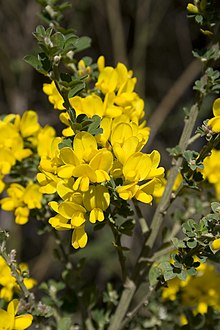Genisteae
| Genisteae | |
|---|---|

| |
| French broom, Genista monspessulana | |
| Scientific classification | |
| Kingdom: | Plantae |
| Clade: | Tracheophytes |
| Clade: | Angiosperms |
| Clade: | Eudicots |
| Clade: | Rosids |
| Order: | Fabales |
| Family: | Fabaceae |
| Subfamily: | Faboideae |
| Clade: | Meso-Papilionoideae |
| Clade: | Genistoids |
| Clade: | Core Genistoids
|
| Tribe: | Genisteae (Bronn) Dumort 1827[1] |
| Genera[2][3] | |
| |
| Synonyms[4] | |
| |
Genisteae is a
The tribe's greatest diversity is in the Mediterranean, and most genera are
Description
The Genisteae arose 32.3 ± 2.9 million years ago (in the
… bilabiate calyces with a bifid upper lip and a trifid lower lip, … the lack of an aril, or the presence of an aril but on the short side of the seed, and stamen filaments fused in a closed tube with markedly dimorphic anthers … and presence of α-pyridone alkaloids.[2]
Most (and possibly all) genera in the tribe produce
Name
Old English bróm is from a common West Germanic *bráma- (Old High German brâmo, "bramble"), from a Germanic stem bræ̂m- from Proto-Indo-European *bh(e)rem- "to project; a point",[12] with an original sense of "thorny shrub" or similar. Use of the branches of these plants for sweeping gave rise to the term broom for sweeping tools in the 15th century, gradually replacing Old English besema (which survives as dialectal or archaic besom).[13]
Cultivation

Brooms tolerate (and often thrive best in) poor soils and growing conditions. In cultivation they need little care, though they need good drainage and perform poorly on wet soils.
They are widely used as ornamental landscape plants and also for wasteland reclamation (e.g. mine tailings) and sand dune stabilising.
Tagasaste (
Species of broom popular in horticulture are purple broom (
Many of the most popular brooms in gardens are hybrids, notably Kew broom (Cytisus ×kewensis, hybrid between C. ardoinii and C. multiflorus) and Warminster broom (Cytisus ×praecox, hybrid between C. purgans and C. multiflorus).
Invasive species
On the east and west coasts of North America, common broom (Cytisus scoparius) was introduced as an

Historical uses
Charles V and his son Charles VI of France used the pod of the broom plant (broom-cod, or cosse de geneste) as an emblem for livery collars and badges.[15]
green is a local common name for the plant.
The flower buds and flowers of Cytisus scoparius have been used as a salad ingredient, raw or pickled, and were a popular ingredient for salmagundi or "grand sallet" during the 17th and 18th century. There are now concerns about the toxicity of broom, with potential effects on the heart and problems during pregnancy.[citation needed]
Scotch Broom is the Plant Badge of Clan Forbes.
See also
- Order of the Broom-cod
- Cytisus scoparius "Scotch Broom"
Notes
References
- .
- ^ .
- USDA; ARS; National Genetic Resources Program (2003). "GRIN genus records of Genisteae". Germplasm Resources Information Network—(GRIN) [Online Database]. Beltsville, Maryland: National Germplasm Resources Laboratory. Archived from the originalon 15 October 2008. Retrieved 4 August 2010.
- ^ Polhill, RM; van Wyk, B-E. (2013). "Kew entry for Genisteae". www.kew.org. London, England: Royal Botanic Gardens, Kew. Archived from the original on 20 March 2014. Retrieved 31 March 2014.
- S2CID 53341490.
- PMID 16085576.
- ISBN 0947643796.
- ISBN 184246017X.
- S2CID 85801868.
- ^ .
- .
- ^ "broom - Origin and meaning of broom by Online Etymology Dictionary". etymonline.com.
- ISBN 978-0199206872.
- ^ http://www.invasive.org/gist/moredocs/cytsco01.pdf [bare URL PDF]
- ^ Nichols JG. (1842). "III. Observations on the Heraldic Devices discovered on the Effigies of Richard the Second and his Queen in Westminster Abbey, and upon the Mode in which those Ornaments were executed; including some Remarks on the surname Plantagenet, and on the Ostrich Feathers of the Prince of Wales". In Society of Antiquaries of London (ed.). Archaeologia: or, Miscellaneous Tracts Relating to Antiquity. Vol. XXIX. J. B. Nichols and Son, London. p. 45.
Further reading
- Mabey, Richard, Flora Britannica, ISBN 1-85619-377-2
- Royal Horticultural Society's plant database
